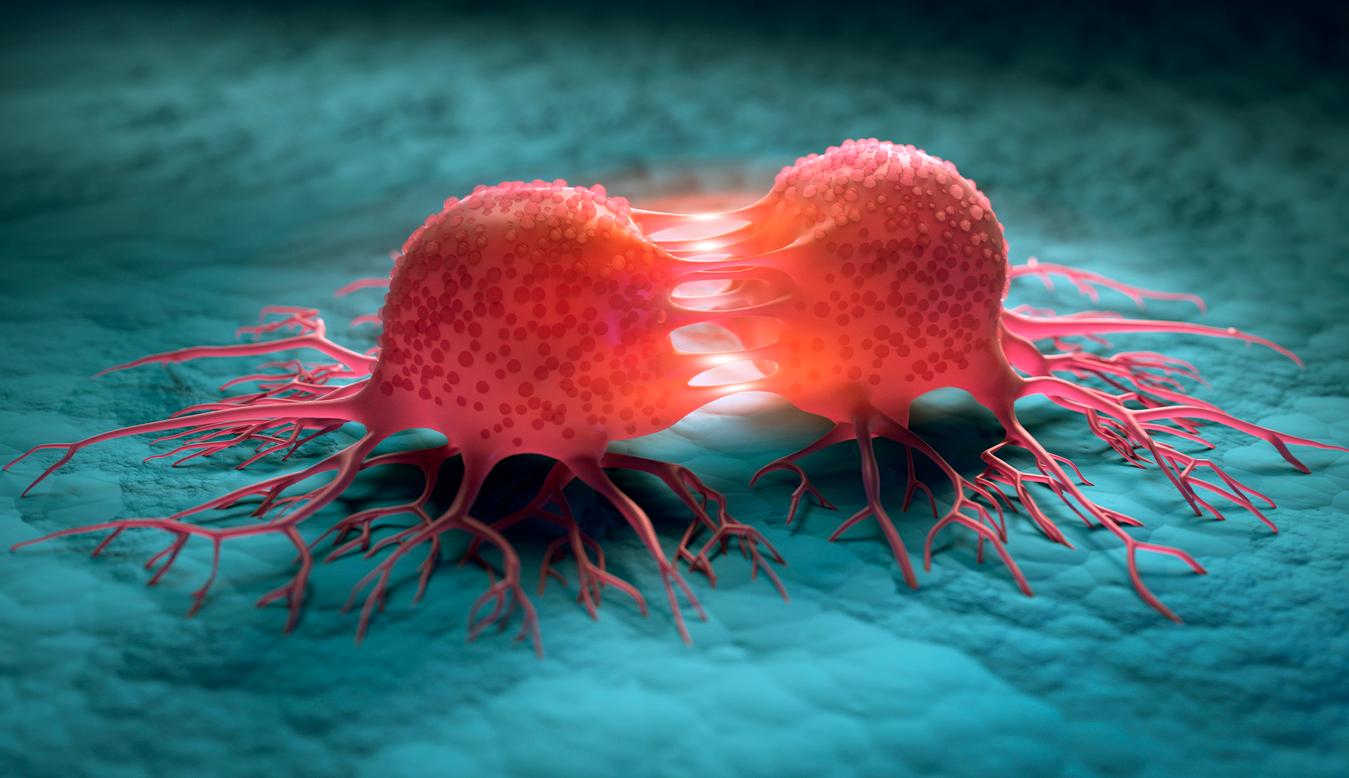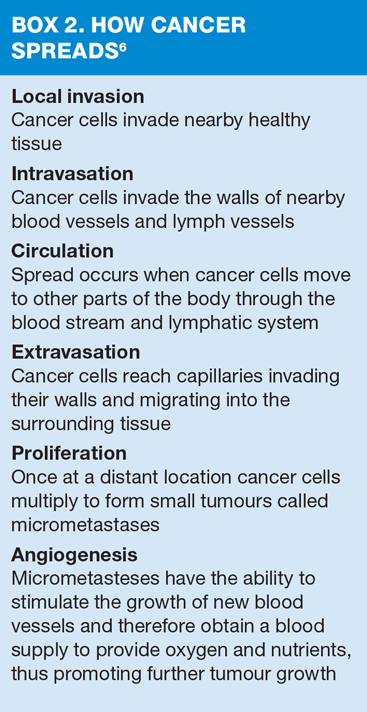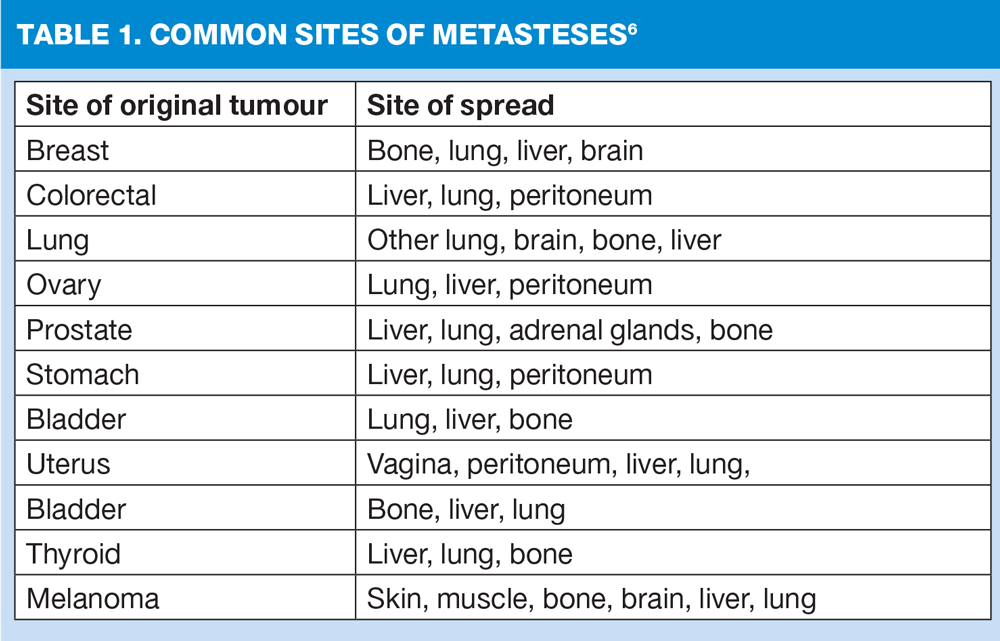
Understanding metastatic cancers
Margaret Perry
Margaret Perry
Advanced Nurse Practitioner
Linkway Medical Practice, West Bromwich
In order to support patients with metastatic cancer, practice nurses need to understand how and why metastases develop - this will give us more confidence when helping our patients cope with their disease
While huge strides have been made in identifying the risk factors for many types of cancer, overall, the incidence is still increasing: rates have risen by more than a third since the mid-1970s, with a new diagnosis being made in the UK every two minutes.1 It goes without saying that the diagnosis is associated with a great deal of distress and fear, not only for the patient but also their friends, family and loved ones.
Cancer can develop at any age, but is most common in older people: more than three out of five new cancers are diagnosed in those aged 65 or over, and over a third of new cancers are diagnosed in those aged 75 or over.2 Unfortunately, many cancers are already advanced by the time they are diagnosed, and for some patients, metastases – secondary tumours – will already be present.
In order to support patients with metastatic cancer practice nurses need to understand how and why metastases develop. This article therefore gives an overview of the topic and aims to give nurses more confidence when helping patients cope with their disease.
WHAT CAUSES CANCER?
Cancer originates from one single cell and occurs when the cell undergoes a number of processes. These changes are the result of the interaction between a person’s genetic factors and three categories of external agents, including physical carcinogens, such as ultraviolet and ionizing radiation; chemical carcinogens, such as asbestos, tobacco smoke, or arsenic (a drinking water contaminant); or biological carcinogens, such as infections from certain viruses, bacteria or parasites.3 The increased incidence of cancer in older adults is thought to be due to the reduced effectiveness of the body’s normal repair mechanisms in combination with a build up of risks for specific cancers that increase with age.3 In the UK, the most common type of cancer is breast cancer, followed by cancers of the lung, prostate, bowel, and malignant melanoma.4
WHAT IS METASTATIC CANCER?
The term is used to describe cancers that have spread from their original site to other parts of the body. This means that the malignant cells found at the new site of invasion are of exactly the same type as those found at the original site. Unfortunately almost all cancers can spread to other sites with the body.
ASSESSING CANCER CELLS AND THE RISK OF SPREAD
A number of factors are taken into account when assessing the aggressiveness of the tumour and the likelihood that metastases will develop. Among the more important factors are cell differentiation, tumour grade and tumour stage.
DIFFERENTIATION
Cells are generally reported as poorly differentiated, well differentiated or moderately differentiated.
Poorly differentiated
Cancer cells of this type are the most worrying. They do not resemble the tissue of origin and do not behave in the same manner. This results in tumours that contain undifferentiated or poorly differentiated cancer cells that tend to be more aggressive, to grow more rapidly, to spread more often and to have a worse prognosis than tumours with either well differentiated or moderately differentiated cells.5
Well differentiated
Tumours with cells of this type tend to be less aggressive, grow much more slowly and, when analysed, have an appearance much closer to normal cells.
Moderately differentiated
These cells have the appearance and behavior mid-way between the above two types. Most types of cancer have moderately differentiated cancer cells.5
TUMOUR GRADE
From the information on cell differentiation the tumour is then graded. Tumours given a lower grade tend to grow slowly while those deemed to be a higher grade are more aggressive in terms of speed of growth and spread.
CANCER STAGE
Staging is used to describe the severity of a cancer taking into account the size of the tumour and whether or not there is spread to other sites in the body. It is useful in deciding which treatment may be beneficial but is also an indicator of prognosis.6 (Box 1)
HOW DOES SPREAD OCCUR?
This process usually involves a number of steps. (Box 2). Spread can occur via the bloodstream or the lymph system. Once cancer cells have entered the blood vessels, they travel as far as capillaries where they must then cross the capillary wall in order to gain access to nearby organs or tissue. It is thought likely that of the many thousands of cancer cells that reach the blood circulation only a few will actually survive to form a secondary cancer, as the majority are ‘killed off’ by the body’s own immune system. Spread via the lymphatic system is a similarly complicated process. The lymphatic system is the body’s filtering system, designed to filter the body’s fluids and to help fight infection. If cancer cells successfully gain access to the lymph system it is possible they will be destroyed, but if they are not they may form new tumours in one or several lymph nodes.
Some cancers favour particular sites to develop metastases. These are shown in Table 1.
DORMANT METASTASES
The process of spread is highly inefficient, and the majority of cells do not survive dissemination.7 Some disseminated tumour cells will immediately begin to proliferate and colonise the new environment, but some, while still viable, will enter what is called a growth-arrested state.8 These cells can remain clinically undetectable for extended periods of time and are described as dormant. It is also thought that tumour dormancy may arise as a response to cancer treatments, the majority of which are designed to target and destroy cells which are rapidly dividing,9 so it is now thought that some cancer cells will use dormancy mechanisms as a means to avoid death. These dormant cells can awaken years later and resume proliferation and colonisation even after the presumably successful treatment of the primary tumour.8 This explains why some cancers metastasise many years after treatment of the primary cancer, with some cancers recurring 20–30 years after they were initially treated.10
CAN METASTASES BE PREVENTED?
The ability of a cancer cell to metastasise successfully depends on a number of factors and not all cancer cells have the ability to metastasise: there is a possibility that non cancerous cells at the original location may be able to block the process.6 Researchers are currently looking for and developing treatments that may, in future, prevent cancer from spreading, but currently the best way to reduce the risk is early detection, excision and treatment. There are screening programmes in operation for breast, bowel and cervical cancers, and the evidence suggests that those who fail to attend for screening are more likely to have cancer detected in its later stages when spread has already occurred.11 For some cancers (e.g. breast cancer) patients are generally given further treatment after surgery to kill any cancer cells that might have broken away from the primary tumour in a bid to reduce the risk of metastases developing.
There is also some positive evidence from studies in recent years suggesting that physical activity in patients already diagnosed with cancer may decrease the risk of recurrence and extend survival.12 One prospective observational study of 933 women with breast cancer found that any moderate intensity exercise after diagnosis, such as brisk walking, reduced mortality risk by 64% compared with inactive women.13 Similar positive benefits have been demonstrated among patients with colorectal cancer where the risk of recurrence was reduced by up to 50% in patients who engaged in physical activity after diagnosis.14
SYMPTOMS
In the early stages there may be few or no symptoms of metastatic disease, and the new growth may only be detected at follow up appointments. However, when these do manifest, they may include general symptoms such as fatigue, tiredness and unexplained weight loss or more specific symptoms directly related to the site of the metastatic growth. For example liver metastases may cause abdominal pain, jaundice and ascites, while metastases in the lung may present with cough and increased shortness of breath.
TREATMENT
Treating metastatic cancer is challenging and needs to take into account factors such as the patient’s age and health status, and the extent of spread. Options include further surgery, chemotherapy, biological therapy, hormonal therapy, radiotherapy, systemic therapy or a combination of these.6 Treatment of metastases is difficult, because while tumour cells in a metastatic location were originally derived from the primary tumour of the originating organ, their response to treatment can be dramatically different: tumour cells at the metastatic site may fail to respond to treatment that was effective for the primary tumour.15 The majority of deaths (about 90%) associated with cancer are due to the metastasis of the original tumour cells to sites distant from the primary tumour.16
PROGNOSIS
Predicting life expectancy is difficult, and there is considerable variation between patients in the way they respond to treatment. Although it is widely held that metastasis to the bone or pleura is not imminently life threatening, metastasis to the liver, lung, or brain often considerably reduces the patient’s life expectancy.15 Other factors linked to a poorer prognosis include shortness of breath, lack of appetite, weight loss and cachexia (generalised wasting).17 Older patients with co-morbidities and poor nutritional status will fare less well than patients who are otherwise fit and well. As the illness progresses the patient becomes more debilitated and their quality of life reduces.
It is worth mentioning that cancer survival rates have improved dramatically over the past 40 years: a recent report by Macmillan predicts that by 2020, only 36% of patients with breast or prostate cancer will die from their disease in contrast to 67% in the 1990s.18 However, these improvements are not reflected across all cancer types.
CONCLUSION
With the increasing numbers of cancer patients across the UK practice nurses can be a resource for support and information, guiding patients through their illness. They can also put patients in contact with organisations that offer advice and support to both sufferers
and their families. Helping patients achieve best quality of life is crucial. Ongoing research will further increase treatment options, and undoubtedly survival rates will continue to improve, but for now early diagnosis and prompt treatment are key to achieving the best outcomes.
REFERENCES
1. Cancer Research UK. Cancer statistics, 2012. http://www.cancerresearchuk.org/health-professional/cancer-statistics
2. Department of Health/ Public Health England. Improving outcomes: A strategy for cancer. Fourth annual report, 2014. https://www.gov.uk/government/uploads/system/uploads/attachment_data/file/388160/fourth_annual_report.pdf
3. World Health Organization. (WHO) Cancer: Factsheet No 297, updated 2015. http://www.who.int/mediacentre/factsheets/fs297/en/
4. Cancer research UK. Twenty most common cancers, 2013. http://www.cancerresearchuk.org/health-professional/cancer-statistics/incidence/common-cancers-compared#heading-Zero
5. Canadian Cancer Society. Tumour grading. https://www.cancer.ca/en/cancer-information/diagnosis-and-treatment/staging-and-grading/tumour-grading/?region=on
6. National Cancer Institute. Metastatic cancer, 2013. http://www.cancer.gov/about-cancer/what-is-cancer/metastatic-fact-sheet
7. Osisami M, Kellar ET. Mechanisms of Metastatic Tumour Dormancy. J Clin Med 2013;2:136-150
8. Chambers AF, Groom AC, MacDonald IC. Dissemination and growth of cancer cells in metastatic sites. Nat Rev Cancer 2002;2:563–572.
9. Lu Z, Luo R.Z, Lu Y et al. The tumour suppressor gene ARHI regulates autophagy and tumour dormancy in human ovarian cancer cells. J Clin Invest 2008;118:3917–3929.
10. Metastases Research Society. Understanding metastases for patients, 2013. http://metastasis-research.org/patients-perspective
11. American Cancer Society. Advanced cancer. http://www.cancer.org/treatment/understandingyourdiagnosis/advancedcancer/advanced-cancer-prevention1
12. Cassileth BR, Yarett I, Lemanne D. Fitness: Can exercise lengthen survival in patient with cancer. http://www.ascopost.com/issues/march-15,-2013/fitness-can-exercise-lengthen-survival-in-patients-with-cancer.aspx
13. Irwin ML, Smith AW, McTiernan A, et al: Influence of pre- and postdiagnosis physical activity on mortality in breast cancer survivors: The health, eating, activity, and lifestyle study. J Clin Oncol 26:3958-3964, 2008.
14. Meyerhardt JA, Giovannucci EL, Holmes MD, et al: Physical activity and survival after colorectal cancer diagnosis. J Clin Oncol. 24:3527-3534, 2006.
15. Finn JW. Determining Prognosis for patients with terminal illness. Am Fam Physician 2006;73(11):2062-2067.
16. Cancer quest. Overview of metastases. http://www.cancerquest.org/metastasis-overview.html
17. Reuben DB, Mor V, Hiris J. Clinical symptoms and length of survival in patients with terminal cancer. Arch Intern Med. 1988;148:1586–91.
18. Macmillan Cancer support. Cancer’s unequal burden. http://www.macmillan.org.uk/Documents/CancersUnequalBurden_2014.pdf
19. NHS choices. What do cancer stages and grades mean? http://www.nhs.uk/chq/Pages/3169.aspx?CategoryID=96
Related articles
View all Articles


